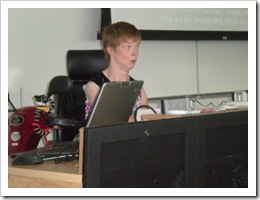Are Multiple Themes Useful in Improving Blog Accessibility?
 A big kudos goes to Gary Jones of BlueFur Hosting for organizing a fantastic WordCamp Fraser Valley! And, a special thank you for including blog accessibility on the agenda.
A big kudos goes to Gary Jones of BlueFur Hosting for organizing a fantastic WordCamp Fraser Valley! And, a special thank you for including blog accessibility on the agenda.
Meeting other local bloggers was great. And, listening to all of the fabulous presenters I realized that the more I learn about WordPress, the more I still have left to learn. If you missed my rockin’ presentation, the ebook “How POUR is Your Blog?†is now available. Go grab a copy!
Response to my presentation was amazing. One idea offered during a break was that blogs could have two themes, one which is simpler or scaled back, and thus more accessible for some readers.
Instantly I cringed inwardly. My mind flashed back to the “text-only version†days, which many designers saw as the only solution to web accessibility, when, in fact, it was the lazy way out. Providing text-only versions may have benefited individuals who used screen readers, but they did not adequately and appropriately accommodate people with other types of disabilities. And, oftentimes, these scaled back versions of websites did not provide all of the same information or it wasn’t updated on the same basis as the regular websites. Text-only versions ghettoized people with disabilities.
However, now that I have had a couple of days to mull it over, perhaps the suggestion has some merits. Because of the nature of blogs, the theme controls the design and layout, the wrapping; the core content (like the posts, comments and such) would remain the same. By offering a choice of themes, readers could choose how they view the content and still participate in the same blog community with fellow readers.
I’m now seeing this option similar to a lower service counter for people in wheelchairs and those of a short stature, rather than a separate entrance with inferior services. But, similar to the aisles still needing to be wide enough in order to get to the lower service counter, the core content and other features would still need be accessible.
What are your thoughts on this? Could this work? Are there any potential limitations or drawbacks? If you have seen this done elsewhere, please share links. I’m curious to see what this might look like.

 Subscribe via RSS
Subscribe via RSS



